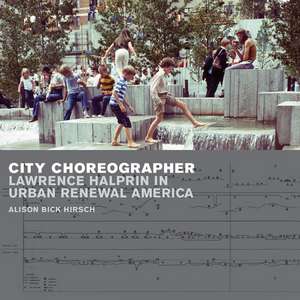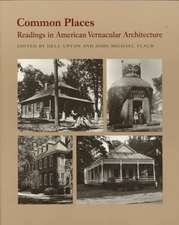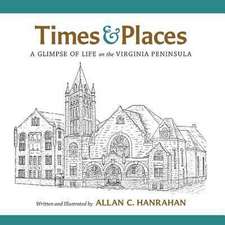City Choreographer: Lawrence Halprin in Urban Renewal America
Autor Alison Bick Hirschen Limba Engleză Paperback – 30 apr 2014
One of the most prolific and influential landscape architects of the twentieth century, Lawrence Halprin (1916–2009) was best known for the FDR Memorial in Washington, D.C., and Sea Ranch, the iconic planned community in California. These projects, as well as vibrant public spaces throughout the country—from Ghirardelli Square and Market Street in San Francisco to Lovejoy Fountain Park in Portland and Nicollet Mall in Minneapolis—grew out of a participatory design process that was central to Halprin’s work and is proving ever more relevant to urban design today.
In City Choreographer, urban designer and historian Alison Bick Hirsch explains and interprets this creative process, called the RSVP Cycles, referring to the four components: resources, score, valuation, and performance. With access to a vast archive of drawings and documents, Hirsch provides the first close-up look at how Halprin changed our ideas about urban landscapes. As an urban pioneer, he found his frontier in the nation’s densely settled metropolitan areas during the 1960s. Blurring the line between observer and participant, he sought a way to bring openness to the rigidly controlled worlds of architectural modernism and urban renewal. With his wife, Anna, a renowned avant-garde dancer and choreographer, Halprin organized workshops involving artists, dancers, and interested citizens that produced “scores,” which then informed his designs.
City Choreographer situates Halprin within the larger social, artistic, and environmental ferment of the 1960s and 1970s. In doing so, it demonstrates his profound impact on the shape of landscape architecture and his work’s widening reach into urban and regional development and contemporary concerns of sustainability.
In City Choreographer, urban designer and historian Alison Bick Hirsch explains and interprets this creative process, called the RSVP Cycles, referring to the four components: resources, score, valuation, and performance. With access to a vast archive of drawings and documents, Hirsch provides the first close-up look at how Halprin changed our ideas about urban landscapes. As an urban pioneer, he found his frontier in the nation’s densely settled metropolitan areas during the 1960s. Blurring the line between observer and participant, he sought a way to bring openness to the rigidly controlled worlds of architectural modernism and urban renewal. With his wife, Anna, a renowned avant-garde dancer and choreographer, Halprin organized workshops involving artists, dancers, and interested citizens that produced “scores,” which then informed his designs.
City Choreographer situates Halprin within the larger social, artistic, and environmental ferment of the 1960s and 1970s. In doing so, it demonstrates his profound impact on the shape of landscape architecture and his work’s widening reach into urban and regional development and contemporary concerns of sustainability.
Preț: 190.28 lei
Nou
Puncte Express: 285
Preț estimativ în valută:
36.41€ • 37.62$ • 30.29£
36.41€ • 37.62$ • 30.29£
Carte disponibilă
Livrare economică 26 februarie-12 martie
Livrare express 11-15 februarie pentru 41.59 lei
Preluare comenzi: 021 569.72.76
Specificații
ISBN-13: 9780816679799
ISBN-10: 0816679797
Pagini: 320
Ilustrații: 105
Dimensiuni: 216 x 216 x 25 mm
Greutate: 0.77 kg
Ediția:New.
Editura: University of Minnesota Press
Colecția Univ Of Minnesota Press
ISBN-10: 0816679797
Pagini: 320
Ilustrații: 105
Dimensiuni: 216 x 216 x 25 mm
Greutate: 0.77 kg
Ediția:New.
Editura: University of Minnesota Press
Colecția Univ Of Minnesota Press
Notă biografică
Alison Bick Hirsch, a landscape and urban designer as well as urban historian and theorist, is assistant professor in landscape architecture at the University of Southern California. She is cofounder and partner of the Foreground design agency, a transdisciplinary practice operating between the fields of architecture, landscape architecture, urbanism, and the visual arts.
Cuprins
Contents
Acknowledgments
Introduction: Scoring the Participatory City
1. The Creative Origins of Larry and Anna HalprinPart I. Built Work2. Framing Civic Rituals: Market Street, Nicollet Mall, Heritage Park Plaza3. Designing with Nature as “Archetypal Precedent”: Portland Open Space Sequence, Seattle Freeway Park, Manhattan Square ParkPart II. Community Workshops4. The Take Part Process: Halprin & Associates in Participatory Design5. Facilitation and/or Manipulation: The Challenges of Taking Part in Fort Worth, Everett, Charlottesville, and Cleveland
Conclusion: Choreography and the Contemporary City
NotesBibliographyIndex
Acknowledgments
Introduction: Scoring the Participatory City
1. The Creative Origins of Larry and Anna HalprinPart I. Built Work2. Framing Civic Rituals: Market Street, Nicollet Mall, Heritage Park Plaza3. Designing with Nature as “Archetypal Precedent”: Portland Open Space Sequence, Seattle Freeway Park, Manhattan Square ParkPart II. Community Workshops4. The Take Part Process: Halprin & Associates in Participatory Design5. Facilitation and/or Manipulation: The Challenges of Taking Part in Fort Worth, Everett, Charlottesville, and Cleveland
Conclusion: Choreography and the Contemporary City
NotesBibliographyIndex
Recenzii
"This is an important study of one of the most significant figures in 20th century landscape architecture and urban design. Alison Bick Hirsch has written the first significant critical assessment of several of Lawrence Halprin's most iconic works nad the historically important and controversial Take Part workshops. With access to his collected papers and both Halprin prior to his death and his wife, the equally important and innovative modern dancer and choreographer, Anna, Hirsch focuses critical attention upon their collaboration and development on urban 'scores' in the tumultuous era of the 1960s and 70s, as well as their dramatic differences." —Laurie D. Olin, partner, The OLIN Studio
"The cogent writing and comprehensive research of the first two sections soar, making this book fundamental to future researchers."—CHOICE
"Hirsch’s book has enough distance from its subject and time period that readers may recognize themselves and their own dilemmas in it."—Planning Magazine
"Hirsch’s book contributes to a growing body of historical research interested in activism and social engagement in environmental design fields."—Planning Perspectives
"Hirsch has authored a handsome book. . . some of the period photos are delightful, featuring children and adults cavorting in fountains and expressing a collective joy in public gathering."—Journal of Planning Education and Research
"Hirsch’s book has enough distance from its subject and time period that readers may recognize themselves and their own dilemmas in it."—Planning Magazine
"Hirsch’s book contributes to a growing body of historical research interested in activism and social engagement in environmental design fields."—Planning Perspectives
"Hirsch has authored a handsome book. . . some of the period photos are delightful, featuring children and adults cavorting in fountains and expressing a collective joy in public gathering."—Journal of Planning Education and Research
Descriere
City Choreographer interprets and explains the participatory design process that was central to the work of landscape architect Lawrence Halprin. Situating Halprin within the larger social, artistic, and environmental ferment of the 1960s and 1970s, it demonstrates his profound impact on the shape of landscape architecture and his work’s widening reach into urban and regional development and contemporary sustainability concerns.



